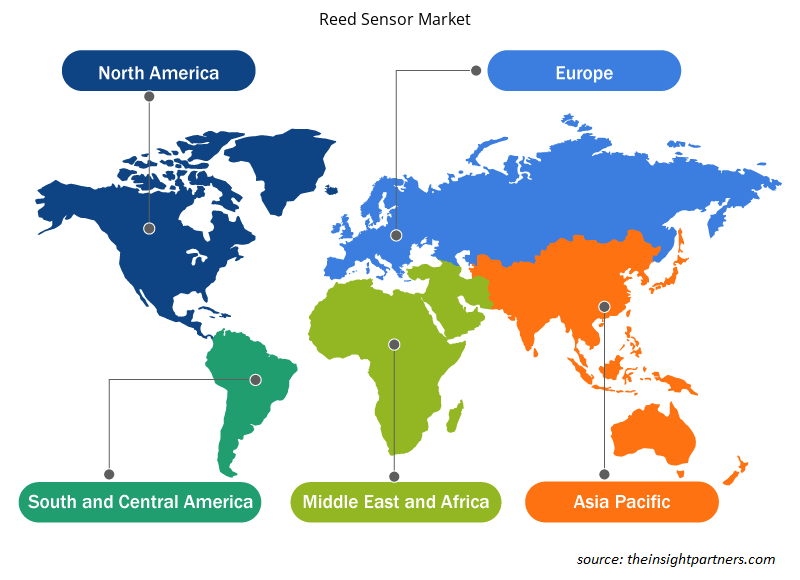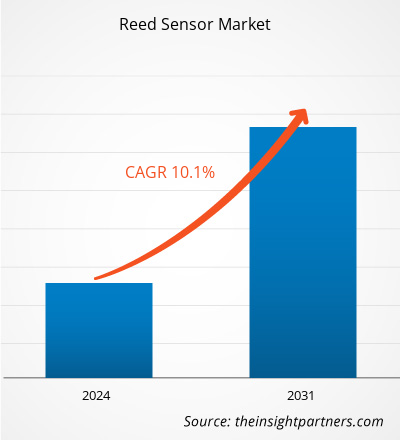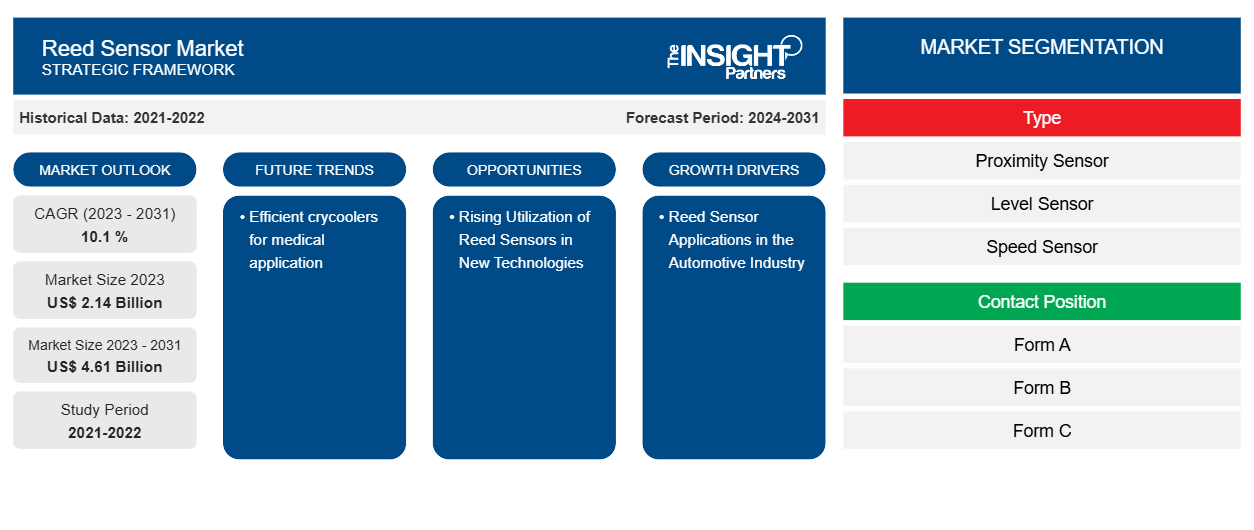Der Markt für Reed-Sensoren soll von 2,14 Milliarden US-Dollar im Jahr 2023 auf 4,61 Milliarden US-Dollar im Jahr 2031 anwachsen. Der Markt soll zwischen 2023 und 2031 eine durchschnittliche jährliche Wachstumsrate (CAGR) von 10,1 % verzeichnen. Die Nachfrage steigt aufgrund einer Vielzahl von Variablen, die technische Entwicklungen in einer Vielzahl von Branchen vorantreiben, rasant an.
Reed-Sensor-Marktanalyse
Reed-Sensoren werden in der Fahrzeugindustrie, insbesondere im Fahrzeuginnenraum, häufig eingesetzt, da sie zuverlässige und einfache Erkennungs- und Betätigungsfunktionen bieten, kostengünstig sind und für den Betrieb keinen Strom benötigen. Daher wird erwartet, dass die Expansion der Automobilindustrie den Einsatz von Reed-Sensoren in Zukunft vorantreiben wird. Allerdings wird erwartet, dass die Nachfrage nach Reed-Sensoren aus der Robotik und Automatisierungstechnik mit der Zeit steigen wird.
Marktübersicht zu Reed-Sensoren
Reed-Sensoren bieten verschiedene Vorteile, darunter einfache und zuverlässige Sensor- und Betätigungsfunktionen, niedrige Kosten und minimalen Strombedarf sowie Sicherheit in rauen Industrieumgebungen. Diese Faktoren tragen zur Marktexpansion bei. Mit der Entwicklung neuer Anwendungen und Technologien gewinnt der Markt an Zugkraft. Sensoren werden in einer Vielzahl von Anwendungen eingesetzt, darunter Telekommunikation, Automobil und Transport, Unterhaltungselektronik und -geräte, Sicherheit und Schutz, Gesundheitswesen, Bauwesen, Robotik und Automatisierung.
Passen Sie diesen Bericht Ihren Anforderungen an
Sie erhalten kostenlose Anpassungen an jedem Bericht, einschließlich Teilen dieses Berichts oder einer Analyse auf Länderebene, eines Excel-Datenpakets sowie tolle Angebote und Rabatte für Start-ups und Universitäten.
-
Holen Sie sich die wichtigsten Markttrends aus diesem Bericht.Dieses KOSTENLOSE Beispiel umfasst eine Datenanalyse von Markttrends bis hin zu Schätzungen und Prognosen.
Treiber und Chancen auf dem Reed-Sensor-Markt
Reed-Sensor-Anwendungen in der Automobilindustrie begünstigen den Markt
Ein Auto enthält eine Reihe von Sensoren, die den ordnungsgemäßen Betrieb seiner zahlreichen Komponenten gewährleisten. Reed-Sensoren werden häufig in Fahrzeuginnenräumen verwendet, um Sicherheit und Zuverlässigkeit zu gewährleisten. Reed-Sensoren sind aufgrund ihres geringen Stromverbrauchs und ihrer langen Lebensdauer perfekt für Automobilanwendungen geeignet. Reed-Sensoren werden in einer Vielzahl von Automobilanwendungen eingesetzt, darunter Sonnenblenden, Frühbremssensoren, Abgassensoren, elektrische Fensterheber, Tankdeckelpositionssensoren, Antiblockiersysteme, Kühlmittelflusssensoren, defekte Lampenerkennung, Überwachung niedriger Flüssigkeitsstände, Batterielebensdaueranzeigen, Sicherheitsgurtverriegelungssensoren, Airbag-Auslöseschutz, Türsensoren, Tempomat und Servolenkung. Das Wachstum der Automobilindustrie treibt den Markt für Reed-Sensoren an.
Zunehmender Einsatz von Reed-Sensoren in neuen Technologien
Der zunehmende Einsatz von Reed-Sensoren in neuen Technologien wird neue Marktchancen schaffen und das Wachstumstempo des Marktes beschleunigen. Der Trend zu hoher Miniaturisierung und außergewöhnlich zuverlässigen Reed-Schaltern wirkt als Treiber für den Reed-Sensor in einer Vielzahl von Endverbraucherbranchen, was auf technologische Fortschritte in der Sensor- und Schaltertechnologie zurückzuführen ist . Darüber hinaus würden günstige Regierungsinitiativen zur Förderung der Produktion von Unterhaltungselektronik in Entwicklungsländern und neuen Schwellenmärkten als Markttreiber wirken und das Wachstumstempo der Branche steigern.
Segmentierungsanalyse des Reed-Sensor-Marktberichts
Wichtige Segmente, die zur Ableitung der Reedsensor-Marktanalyse beigetragen haben, sind Typ, Kontaktposition und Anwendung.
- Basierend auf dem Typ ist der Markt für Reed-Sensoren in Näherungssensoren, Füllstandssensoren, Geschwindigkeitssensoren und Durchflusssensoren unterteilt.
- Basierend auf der Kontaktposition ist der Markt für Reedsensoren in Form A, Form B, Form C, Form D und andere segmentiert.
- Nach Anwendung ist der Markt in die Bereiche Automobil und Transport, Sicherheit und Schutz, Medizin, Unterhaltungselektronik, Telekommunikation und Sonstige segmentiert.
Reed-Sensor-Marktanteilsanalyse nach Geografie
Der geografische Umfang des Marktberichts für Reed-Sensoren ist hauptsächlich in fünf Regionen unterteilt: Nordamerika, Asien-Pazifik, Europa, Naher Osten und Afrika sowie Südamerika/Süd- und Mittelamerika. Der Asien-Pazifik-Raum wird den etablierten Elektronik- und Automobilsektoren in Taiwan bzw. China zugeschrieben. Shanghai und Peking sind Chinas wichtigste Industriezentren für Autos, Kommunikationsgeräte und Elektronik, was die Marktexpansion für Reed-Sensoren vorantreibt. In Südkorea trägt das Wachstum von Smart-Home-Geräten zum Wachstum des Reed-Sensor-Marktes bei.
Regionale Einblicke in den Reed-Sensor-Markt
Die regionalen Trends und Faktoren, die den Reed-Sensor-Markt während des Prognosezeitraums beeinflussen, wurden von den Analysten von Insight Partners ausführlich erläutert. In diesem Abschnitt werden auch die Marktsegmente und die Geografie des Reed-Sensor-Marktes in Nordamerika, Europa, im asiatisch-pazifischen Raum, im Nahen Osten und Afrika sowie in Süd- und Mittelamerika erörtert.

- Erhalten Sie regionalspezifische Daten zum Reed-Sensor-Markt
Umfang des Marktberichts zu Reed-Sensoren
| Berichtsattribut | Details |
|---|---|
| Marktgröße im Jahr 2023 | 2,14 Milliarden US-Dollar |
| Marktgröße bis 2031 | 4,61 Milliarden US-Dollar |
| Globale CAGR (2023 - 2031) | 10,1 % |
| Historische Daten | 2021-2022 |
| Prognosezeitraum | 2024–2031 |
| Abgedeckte Segmente |
Nach Typ
|
| Abgedeckte Regionen und Länder |
Nordamerika
|
| Marktführer und wichtige Unternehmensprofile |
|
Dichte der Marktteilnehmer für Reed-Sensoren: Deren Auswirkungen auf die Geschäftsdynamik
Der Markt für Reed-Sensoren wächst rasant. Dies wird durch die steigende Nachfrage der Endnutzer aufgrund von Faktoren wie sich entwickelnden Verbraucherpräferenzen, technologischen Fortschritten und einem größeren Bewusstsein für die Vorteile des Produkts vorangetrieben. Mit der steigenden Nachfrage erweitern Unternehmen ihr Angebot, entwickeln Innovationen, um die Bedürfnisse der Verbraucher zu erfüllen, und nutzen neue Trends, was das Marktwachstum weiter ankurbelt.
Die Marktteilnehmerdichte bezieht sich auf die Verteilung von Firmen oder Unternehmen, die in einem bestimmten Markt oder einer bestimmten Branche tätig sind. Sie gibt an, wie viele Wettbewerber (Marktteilnehmer) in einem bestimmten Marktraum im Verhältnis zu seiner Größe oder seinem gesamten Marktwert präsent sind.
Die wichtigsten auf dem Reed-Sensor-Markt tätigen Unternehmen sind:
- HSI-Sensorik
- Coto-Technologie
- Littelfuse Inc.
- PIC GmbH
- Pickering Electronics Ltd.
- RMCIP
Haftungsausschluss : Die oben aufgeführten Unternehmen sind nicht in einer bestimmten Reihenfolge aufgeführt.

- Überblick über die wichtigsten Akteure auf dem Reed-Sensor-Markt
Neuigkeiten und aktuelle Entwicklungen zum Reed-Sensor-Markt
Der Markt für Reed-Sensoren wird durch die Erhebung qualitativer und quantitativer Daten nach Primär- und Sekundärforschung bewertet, die wichtige Unternehmensveröffentlichungen, Verbandsdaten und Datenbanken umfasst. Im Folgenden finden Sie eine Liste der Entwicklungen auf dem Markt:
- Im März 2021 stellte ABLIC Inc. den oberflächenmontierten TMR-Sensor-IC (Tunnel Magneto Resistance) „S-5701 B Series“ vor, einen Magnetsensor mit extrem niedrigem Stromverbrauch, hoher magnetischer Empfindlichkeit, verlängerter Lebensdauer und einem Betriebsstromverbrauch von unter 160 nA.
(Quelle: ABLIC Inc., Unternehmenswebsite, 2021)
- Im August 2023 stellte Littelfuse, Inc. seine neuesten Produkte vor, die 59155 und 59156, die weltweit kleinsten Subminiatur-Reedsensoren zur Flanschmontage. Die Architektur der Sensoren ermöglicht eine kompakte Größe, berührungslose Aktivierung und Anpassung, wodurch sie für eine breite Palette von Anwendungen mit engen Abständen in verschiedenen Branchen geeignet sind.
(Quelle: Littelfuse, Inc., Unternehmenswebsite, 2022)
Marktbericht zu Reed-Sensoren – Abdeckung und Ergebnisse
Der Bericht „Marktgröße und Prognose für Reed-Sensoren (2021–2031)“ bietet eine detaillierte Analyse des Marktes, die die folgenden Bereiche abdeckt:
- Marktgröße und Prognose auf globaler, regionaler und Länderebene für alle wichtigen Marktsegmente, die im Rahmen des Projekts abgedeckt sind
- Marktdynamik wie Treiber, Beschränkungen und wichtige Chancen
- Wichtige Zukunftstrends
- Detaillierte PEST/Porters Five Forces- und SWOT-Analyse
- Globale und regionale Marktanalyse mit wichtigen Markttrends, wichtigen Akteuren, Vorschriften und aktuellen Marktentwicklungen
- Branchenlandschaft und Wettbewerbsanalyse, einschließlich Marktkonzentration, Heatmap-Analyse, prominenten Akteuren und aktuellen Entwicklungen
- Detaillierte Firmenprofile
- Historische Analyse (2 Jahre), Basisjahr, Prognose (7 Jahre) mit CAGR
- PEST- und SWOT-Analyse
- Marktgröße Wert/Volumen – Global, Regional, Land
- Branchen- und Wettbewerbslandschaft
- Excel-Datensatz
Aktuelle Berichte
Verwandte Berichte
Erfahrungsberichte
Grund zum Kauf
- Fundierte Entscheidungsfindung
- Marktdynamik verstehen
- Wettbewerbsanalyse
- Kundeneinblicke
- Marktprognosen
- Risikominimierung
- Strategische Planung
- Investitionsbegründung
- Identifizierung neuer Märkte
- Verbesserung von Marketingstrategien
- Steigerung der Betriebseffizienz
- Anpassung an regulatorische Trends























 Kostenlose Probe anfordern für - Markt für Reed-Sensoren
Kostenlose Probe anfordern für - Markt für Reed-Sensoren